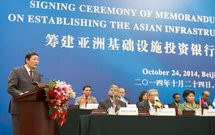 The Asian Infrastructure Investment Bank (AIIB) was recently launched in Beijing and will be operational by 2015. China’s proactive role in the matter has alarmed other world powers, begging the question: what are China’s objectives and does the bank mark the beginning of a new regional order?
The Asian Infrastructure Investment Bank (AIIB) was recently launched in Beijing and will be operational by 2015. China’s proactive role in the matter has alarmed other world powers, begging the question: what are China’s objectives and does the bank mark the beginning of a new regional order?
Objectives
The AIIB is an initiative by the new Chinese leadership that seeks a more equal and balanced development model in Asia. The total capital of the bank is USD 100 billion, the initial capital will be 50 billion, and the paid in ratio will be 20 per cent. China being the second largest economy falls in the ‘Category II’ voting bloc at the World Bank, while at the Asian Development Bank it has a 5.5 per cent share. The Asian Development Bank (ADB) is always headed by Japan. China, along with other countries, therefore seeks to change the representation at these institutions.
Twenty-one countries along with China have joined the AIIB; India has joined because it wants better representation in an international economic institution. Thailand joined the bank because it was looking for an alternative means to fund its transport system. Some countries, like Australia, South Korea and Indonesia were not present at the inauguration. It thus shows that the members have joined the bank willingly and have not been co-opted by the Chinese. Although the structural modalities of the bank have not yet been spelled out, this is not the first time that a regional bank is being established. The Europe Bank for Reconstruction and Development (EBRD) has been functioning since 1991, when the Soviet Union dissolved.
Recently, there have been questions about China ‘peaceful development’. In terms of a foreign policy agenda, the AIIB is a step towards projecting China as responsible regional player and subsequently a global power. It the Chinese alternative to the Trans Pacific Partnership (TPP) led by the US and Japan and an answer to the US ‘pivot to Asia’. It is an endeavour by China to discourage Asian countries to seek help from the US or US-led institutions, thereby restricting its entry into Asia. The bank will also highlight China’s significant experience in infrastructure financing, and indeed, multilateral development banking in general. Also, the APEC summit is scheduled for November 2014, and China might have wanted to launch the bank prior to it so that a formal announcement could be made at the summit in the presence of the US.
The Chinese economy is set to reach USD 10 trillion this year with a trade surplus of three trillion, and it wants to invest the money in a way that will increase its international status. This bank will be vital in tapping China’s excess savings and utilising them for developing Asia. As a result, it will help China legalise the RMB and reduce its own direct lending. This will create opportunities for Chinese companies to get contracts for projects. The ASEAN Economic Community (AEC) is also scheduled to start functioning by the end of 2015 - China thus wants to start the bank before the AEC becomes functional so that it can involve ASEAN countries in the projects. Consequently, the bank will add value to China’s relations with its neighbours by deepening trade ties.
A New Regional Order?
Asian countries are growing at a fast pace; by 2030 they will account for almost half of the global GDP. According to a report by the ADB, in the next decade, Asian countries will need USD8 trillion in infrastructure investments to maintain the current economic growth rate. Existing institutions like the ADB neither have the capital nor the expertise to cater to infrastructural needs. On the contrary, China has the money and the experience from its remarkable infrastructure development path. Drawing from China’s experience, the bank will help in providing the required infrastructure for the ‘Asian Century’.
It will give credit for investments in real economy unlike the ‘Washington Consensus’; the first proposed project of the bank is the New Silk Road and the Maritime Silk Road (MSR). Both the projects are oriented towards infrastructure development and connectivity in the region. Again, these projects will not only benefit China but the countries along which they are located and certainly, the region as a whole.
Asian economies are expanding and are expected to become more complex and interconnected. Such initiatives will help to sustain the pace of their development. This marks the beginning of a new era led by China as the leader and not the US, and will help China enhance its claim as a regional leader as this is the first initiative to strengthen economic coordination within the Asian region.
By Special Arrangement with Institute of Peace and Conflict Studies (http://www.ipcs.org)